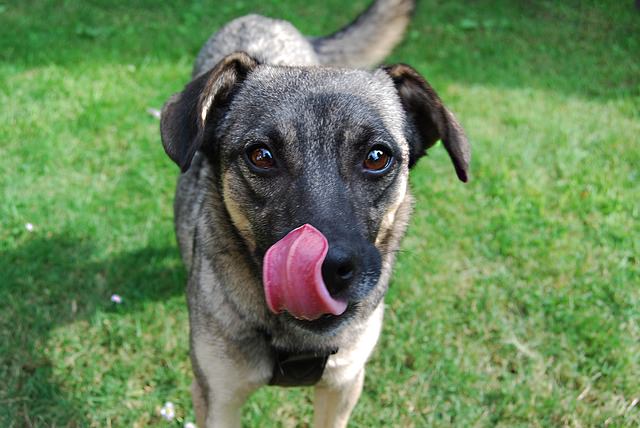Does your dog do strange things? Repetitive behaviors that seem to have no purpose? People wonder and ask me why their dogs do many things. Many of them have an explanation that I can elucidate for the owners, but some things really are not that simple. I get a lot of questions in my inbox, on social media and from my clients about this type of conduct and each case is individual and complex.
Some of the behaviors that I have been asked about include flank sucking in Doberman Pinschers (the dog will literally suck on his own flank repeatedly), fly biting in Labs (snapping at imaginary flying insects randomly) and acral lick granulomas (habitual licking of an area until the skin is ulcerated) in many breeds. My most recent query is a terrier that licks her owner’s feet to the point he must wear socks to prevent it.

The definition of stereotypical behavior is constant repeating behavior that serves no obvious purpose. To me, the behavior is not truly abnormal unless it interrupts the animal’s ability to do other normal daily tasks or is so unrelenting that it annoys the owner and disrupts the human-animal bond. In these cases, it is more critical that we try to get to the bottom of the behavior and try to reduce it and just because the purpose is not obvious does not mean it is not there at all.
In humans, compulsions are thought to be behaviors designed to reduce stress and are often referred to as OCD (Obsessive Compulsive Disorder).(2) Some veterinary behaviorists feel that animals are not capable of the thought processes required for obsession and like to term the disorder for animal patients as merely Compulsive Disorder (CD). True Compulsive Disorder in animal patients must occur in the absence of any underlying medical condition, so there are different camps on how to explain and manage these types of behaviors. The possibility of covering up a stereotypical behavior with anxiety medications when there may be an underlying medical issue gives many people pause and our ability to truly assess mental wellness in animals is limited.

Underlying Medical Condition
As early as 1998, researchers discussed that repetitive licking behavior (self or others/objects) seemed to relate to other medical conditions, but the actual relationship between medical and behavioral issues has not been studied. (3) Even though it could be difficult to pin down exactly which medical cause contributed to the development of the behavior (in this case usually persistent licking), it is very important to rule out or address those issues that can be identified. Causes of many of these compulsive reactions could include skin disease, cancers or pain and if your dog is trying to tell you about any of these, it would be a shame to stop her communication before the message was explored.
True Behavioral Disorder
Dobermans that exhibit the flank sucking tendency have been studied and researchers were able to actually identify structural differences in the brains of affected dogs. These studies suggest that the conduct is primary (originating in the brain itself, rather than being a manifestation of another issue). It is thought that this type of issue is not contributed to by systemic disease and would have to be managed with psychotropic medications. These cases of primary CS in dogs are not something I see regularly in my practice. They are not as common in my experience as the cases caused by an underlying systemic disease, so it is important not to dismiss a stereotypical behavior as a “behavioral problem” that must be tolerated and not explored.

Insistent Behavior in an attempt to communicate
There have been numerous examples in which dogs were performing repetitive behaviors that proved to be an attempt to communicate something about a loved one. There is mounting evidence that dogs are able to recognize cancers by scent and certainly dogs have been employed in the monitoring of seizure patients. The case of Maureen and her dog, Max was first seen last year on BBC. Max had developed a habit of nosing Maureen in the breast insistently. According to her story, a mammogram failed to reveal the lesion, but Max was so adamant that she eventually persisted and got a biopsy that showed her cancer. After surgery and treatment, Max seemed satisfied. One of my clients reports that her English Bulldog seems to know and alert them when her other dog, an epileptic Chihuahua is experiencing seizures. It took them a few times to realize what he was trying to tell them, but now the pattern has proved to be consistent with an alert message from him in concern for his pack mate sister.
If your dog exhibits signs of compulsive behavior, make sure she is not trying to tell you something. Her message might be about her own health… or even about yours!
- Repetitive behaviors in cats and dogs: are they really a sign of obsessive-compulsive disorders (OCD)? Canadian Veterinary Journal; 2013 Feb;54(2):129-31.
- Diagnostic criteria from DMS-IV-TR Obsessive-compulsive disorder. The American Psychiatric Association; 2000. pp. 217–218.
- Hewson CJ, Luescher UA, Ball RO. Measuring change in the behavioural severity of canine compulsive disorder: The construct validity of categories of change derived from two rating scales. Appl Anim Behav Sci. 1998;60:55–68.
- Brain structural abnormalities in Doberman pinschers with canine compulsive disorder. Prog Neuropsychopharmacol Biol Psychiatry. 2013 Aug 1;45:1-6. doi: 10.1016/j.pnpbp.2013.04.002. Epub 2013 Apr 13. Ogata et al.
- Canine olfactory detection of malignant melanoma. BMJ Case Rep. 2013 Oct 14;2013. pii: bcr2013008566. doi: 10.1136/bcr-2013-008566.
